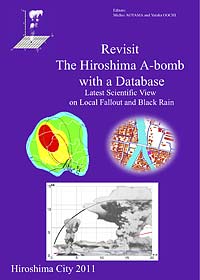
|
You
are : Home Publications Publications |
 |
 |
Publications |
Revisit The Hiroshima A-bomb with a Database Volume2 New!
 (c) 2013 by Hiroshima City
(c) 2013 by Hiroshima City |
edited by Michio Aoyama and Yutaka Oochi
ISBN 978-4-9905935-1-3
Publisher: Hiroshima City
March 2013
 Extracts [PDF file] Extracts [PDF file]
Available on request.
For person who wishes to obtain this book, please contact HiSoF.
On August 6, 1945, a single atomic bomb reduced the streets of Hiroshima to rubble,
taking many precious lives.
Making clear the reality of the atomic bombing and relaying to the next generation
the full scope of that unprecedented disaster is the mission of Hiroshima, alongside seeking the total abolition of nuclear
weapons.
In 2010, the City of Hiroshima, in order to explain the true nature of the damage
from the bombing, established the Hiroshima Study Group on Re-construction of Local Fallout from A-bomb in 1945 (HiSoF). This
group brought together experts in geochemistry, radiobiology, nuclear engineering, and other fields to study collections of the
latest scientific findings and data with the goal of clarifying the true state of Hiroshima’s radioactive fallout.
This book is a volume 2 of the previously published essay collection of July 2011
“Revisit The Hiroshima A-bomb with a Database-Latest Scientific View on Local Fallout and Black Rain-”, that includes the newest
results and data.
We sincerely hope that through this book, research on the reality of the damage
from the bombing will further develop both domestically and internationally, and many people will feel compelled to work for
a peaceful world without nuclear weapons due to their deepened understanding of the A-bomb’s disastrous effects.
From
the Preface by Mayor of Hiroshima City, Kazumi Matsui
Contents
1. Initial Conditions
1.1 Aerological data in August 1945 at Hiroshima, Japan
Michio Aoyama, Masaru Chiba, Manami Suzuki
1.2 Neutron activation analysis for soils of Hiroshima City and plaster under roof-tiles of Old Hiroshima House
Satoru Endo, Yuta Taguchi, Tetsuji Imanaka, Satoshi Fukutani, Evgeniya Granovskaya, Masaharu Hoshi, Kotaro Shiraishi, Tsuyoshi Kajimoto, Kiyoshi Shizuma
1.3 Soil particle size measurements for the calculation of the spread of dusts blown up by the explosion of the
Hiroshima atomic bomb
- For radiation dose estimation from neutron activated dusts of soils used in traditional Japanese houses and those of the ground surface -
Aya Sakaguchi, Masaharu Hoshi, Michio Aoyama, Hiroaki Kato, Yuichi Onda
2. Validation Data
2.1 Investigation on circular asymmetry of geographical distribution in cancer mortality of Hiroshima atomic
bomb survivors based on risk maps: analysis of spatial survival data
Tetsuji Tonda, Kenichi Satoh, Keiko Otani, Yuya Sato, Hirofumi Maruyama, Hideshi Kawakami, Satoshi Tashiro, Masaharu Hoshi, Megu Ohtaki
2.2 Estimation of close-in fallout 137Cs deposition level due to the Hiroshima atomic bomb from soil samples
under houses built 1–4 years after the explosion
Masayoshi Yamamoto, Masaharu Hoshi, Kassym Zhumadilov, Satoru Endo, Aya Sakaguchi, Tetsuji Imanaka, Yutaka Miyamoto
2.3 Gamma-ray thermoluminescence measurements: a record of fallout deposition in Hiroshima?
Stephen D. Egbert, George D. Kerr
Appendix
Details of sampling points of under floor soil samples used in Yamamoto‘s paper in this book
Index
List of reprint permissions
About
the editors
Michio Aoyama is senior scientist of Geochemical Research Department, Meteorological Research Institute, Tsukuba, Japan.
Yutaka Oochi is director of Atomic Bomb Survivors Relief Department, Hiroshima City.
Revisit The Hiroshima A-bomb with a Database : Latest
Scientific View on Local Fallout and Black Rain
 (c) 2011 by Hiroshima City
(c) 2011 by Hiroshima City |
edited by Michio Aoyama
and Yutaka Oochi
ISBN 978-4-9905935-0-6
Publisher: Hiroshima City
July 2011
 Extracts
[PDF file] Extracts
[PDF file]
Available on request.
For person who wishes to obtain this book, please contact HiSoF.
Although many studies
have been done on Hiroshima's radioactive fallout and the black
rain that fell after the bombing, we have yet to fully understand
its impact. As such, in 2010 we established the Hiroshima Study
Group on Re-construction of Local Fallout from A-bomb in 1945
(HiSoF) to bring together experts in geochemistry, radiation biophysics,
nuclear engineering, and other fields to further evaluate the
extent and effects of Hiroshima's black rain and other radioactive
fallout.
We created this book,
which includes HiSoF's latest findings and data on the conditions
right after the bombing, to facilitate collaborative research
with experts in Japan and abroad. We sincerely hope it will become
the basis for future studies on Hiroshima's radioactive fallout
and damage, and that in turn, many more people will come to realize
the A-bomb's disastrous effects and feel compelled to work for
a peaceful world without nuclear weapons.
From
the Preface by Mayor of Hiroshima City, Kazumi Matsui
Contents
1. Initial Conditions
1.1 Initial process
of atomic bomb cloud formation and radioactivity distribution
Tetsuji Imanaka
1.2 Mapping the Fire
Field near the Hypocenter of the Hiroshima A-bomb
Noriyuki Kawano, Megu Ohtaki, Takao Okada
1.3 Digital mapping
of Hiroshima just before and after the atomic Bombing
Toshio Koizumi
1.4 Resources of
heat, water and carbon fluxs for an induced urban fire in 1945
Hiroshima based on field research of Japanese traditional houses
Yoshihiro Okada and Michio Aoyama
1.5 Estimation of
heat, water, and black carbon fluxs during the fire induced
by the Hiroshima A-bomb
Michio Aoyama, Noriyuki Kawano, Toshio Koizumi, Takao Okada,
Yoshihiro Okada, Megu Ohtaki, Takahiro Tanikawa
1.6 Height Estimation
of Hiroshima A-bomb Mushroom Cloud from Photos
Masashi Baba, Fumio Ogawa, Shinsaku Hiura, Naoki Asada
2. Validation Data
2.1 Radiation survey
activities in the early stages after the atomic bombing in Hiroshima
Tetsuji Imanaka
2.2 137Cs concentration
in Soil Samples Collected in an Early Survey of Hiroshima Atomic
Bomb and 235U/238U Ratios in Black Rain Streaks on a Plaster
Wall
Kiyoshi Shizuma
2.3 Preliminary results
on 137Cs in soil core samples collected from the under-floors
of houses built within 1-4 years after the Hiroshima Atomic
Bomb
Aya Sakaguchi, Haruka Chiga, Kiyoshi Shizuma, Masaharu Hoshi,
Masayoshi Yamamoto
2.4 Geospatial Analysis
of 137Cs in Hiroshima Soil Cores Collected in 1976 and 1978
Harry M. Cullings
2.5 A review of Masuda's
re-investigation of 'black rain' after the Hiroshima A-bomb
Yoshinobu Masuda
2.6 Re-construction
of spatial-time distribution of 'black rain' in Hiroshima based
on statistical analysis of witness of survivors from atomic
bomb
Megu Ohtaki
2.7 Feasibility of
using 236U to reconstruct close-in fallout deposition from the
Hiroshima atomic bomb
Aya Sakaguchi, Kenta Kawai, Peter Steier, Tetsuji Imanaka,
Masaharu Hoshi, Satoru Endo, Kassym Zhumadilov, Masayoshi Yamamoto
3. Databases
Sources and a structure
of database for numerical model simulation of the Hiroshima
A-bomb in 1945
Michio Aoyama and HiSoF members
Appendix I
State and spread of fires in Hiroshima City
Appendix II
Meteorological Conditions Relating to the Atomic Bomb Explosion
in Hiroshima City (1947, Synopsis)
Appendix III
History of Rainfall Areas
Index
List of reprint permissions
About
the editors
Michio Aoyama
is senior scientist of Geochemical Research Department, Meteorological
Research Institute, Tsukuba, Japan.
Yutaka Oochi is director of Atomic Bomb Survivors Relief
Department, Hiroshima City.
 |
 |
Related
documents |
Current status of studies on radioactive fallout with "black
rain" due to the Hiroshima atomic bomb
edited by Masaharu Hoshi
and Tetsuji Imanaka (RGHBR)
In May 2010, the Research
Group for Hiroshima "black rain" Radioactivity (RGHBR)
issued a preliminary report on studies regarding radioactive fallout
with "black rain" resulting from the Hiroshima atomic
bomb. The report suggested the area exposed to "black rain"
may have been wider than previously estimated.
 Full
report (Japanese, partly English) [PDF file] Full
report (Japanese, partly English) [PDF file]
 Extracts
(English papers only) [PDF file] Extracts
(English papers only) [PDF file]
Feasibility of using
U236 to reconstruct close-in fallout deposition from the Hiroshima
Atomic Bomb
by A.Sakaguchi, K.Kawai,
P.Steier, T.Imanaka, M.Hoshi, S.Endo, K.Zhumadilov, M.Yamamoto
Science of the Total Environment, Vol.408, Issue 22, Page 5392-5398
 Abstract Abstract
Handling of Fallout Processes
from Nuclear Explosions - in Severe Nuclear Accident Program (SNAP)
By Jørgen Saltbones,
Jerzy Bartnicki and Anstein Foss, Norwegian Meteorological Institute
 Shortened
version (full report available on request from atuthors and
HiSoF) [PDF file] Shortened
version (full report available on request from atuthors and
HiSoF) [PDF file]
|



